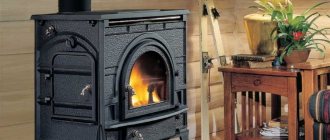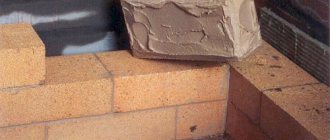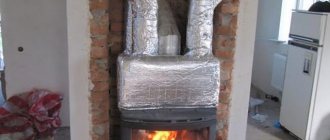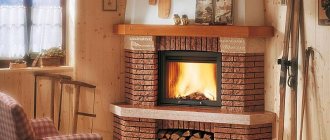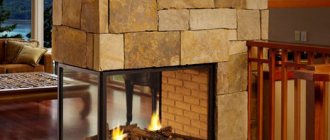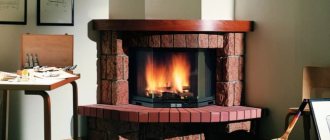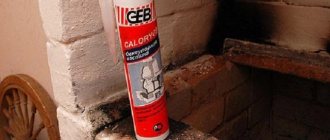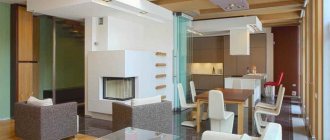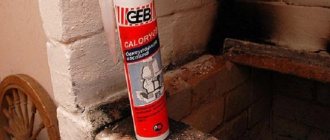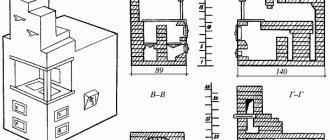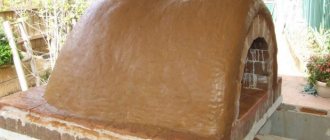History and types of biofireplaces
Ancient people used the idea of a fireplace not only to produce heat in winter, but also for cooking, heating water and other household purposes. In those days, their fire pits were built in the ground, in the center of the hut, or even inside caves. Smoke canopies are then invented in the Middle Ages to prevent smoke from occupying an enclosed area. This idea led to the invention of chimneys in the 11th or 12th century. This development has improved the functionality of fireplaces, since the problem of smoke is effectively solved.
In terms of design and appearance, fireplaces have changed a lot.
Biofireplace - whether it heats or not, considering that it has moved far from the design of the past. Faulty architectures of the past have been improved with advanced technology, while designs have been developed in terms of preferred style and finishes. From the visual elements to the actual structure, fireplaces have truly evolved over time.
Types of Gas Fireplaces
- Gas Fireplace Insert. This is used to convert an existing, built-in metal or traditional wood fireplace to a gas type. Using an insert is much cheaper than a complete fireplace renovation. It can change the atmosphere of your home from rustic and traditional to modern.
- Gas Fireplace with zero clearance. This is a prefabricated type of fireplace that can be installed during home construction or a complete renovation, mainly when the home does not have an existing fireplace. It can be placed inside the shell of the house or against an external wall, depending on the overall architecture of the house.
- Autonomous gas fireplace. It is a free-standing unit with a tempered or ceramic glass front. This type of fireplace tends to be more efficient in providing heat around the home since all of its surfaces are exposed.
The fireplace is in many ways one of the best places in the house. This causes some level of heat in the home, especially on winter days. However, it also has its own disadvantages, as we are about to find out.
What factors need to be taken into account first?
When choosing a boiler or stove, you should identify the first, most important characteristics of the building itself and the needs of the people living in it. Of great importance is:
- total area of the house
- number of floors, rooms and other premises requiring heating
- number of people living in the house
- presence of a gas main near the house
- Availability of an autonomous/common electrical network
- preferred source of energy that one wants to use
- presence or absence of need for a hot water supply system
HOUSE AREA.
The power of the heating equipment will depend on the total area of the house and the rooms requiring heat. Houses and cottages with a size of up to 100 square meters can be heated using a fireplace or stove. But it will be almost impossible to fill buildings over 100 square meters with heat with one ordinary stove; a boiler will be required here. Particularly relevant is not only the footage, but also the number of storeys of the house - two or more floors require the installation of a boiler unit, or the placement of a separate fireplace or stove on each floor.
NUMBER OF ROOMS AND FLOORS.
The power of the heat-generating equipment, as well as the total volume of heat required, depends on the number of rooms that need to be heated. Let's say, for a one-story cottage with two rooms and one kitchen, one stove with a water circuit or an air heating system is suitable. By connecting heat distribution pipes to the fireplace, it can be directed to any room using air ducts. In the case of a furnace with a water circuit, instead of air ducts, pipes are used to supply coolant to radiators and radiators located in selected rooms. You can also connect a boiler to the water circuit of the stove, thus organizing an independent hot water supply system.
But for houses with several floors or large footage, one fireplace with air ducts or a hydraulic circuit will not be enough. The unit may not be able to cope with the heating of large volumes of space, or it will use such a large amount of energy resources that it will simply become economically unaffordable. In such cases, a boiler device is chosen, since its power and performance, together with the piping and heat distribution system, allows for heating large areas and several floors at once.
THE PRESENCE OF GAS OR ELECTRIC MAINS NEAR THE BUILDING.
This factor is important to consider when choosing the energy carrier option on which the future heating device will operate. Gas heating today is the most cost-effective because gas is very cheap. If there is a gas main near the house, then you can have no doubt and choose a gas boiler, since its use and maintenance will be inexpensive. But the heating quality will be at an excellent level. There is a slightly different issue with electricity as energy for boiler operation: modern electricity tariffs are quite high, so heating with an electric boiler will be completely unprofitable, especially if the total area is large.
The difference in the cost of the energy source is reflected in the price of boiler units: gas boilers are more expensive than electric ones. But a gas boiler, due to its low cost, quickly pays for itself during operation, unlike an electric one - its cost will only increase over time due to high utility bills for light. If you want to use gas or electricity, there is no need to consider the option of installing a stove as an independent heater, since they operate on wood, pellets or coal. The only exceptions are gas or electric fireplaces, but their power is quite low.
PREFERRED TYPE OF ENERGY SOURCE FOR HEATING.
When choosing a stove/fireplace or boiler, it is important to make a decision - what kind of fuel you want to use for heating purposes. Today, the following types are used to generate heat:
- gas
- electricity
- firewood
- pellets
- coal
- diesel/diesel
Boiler units support operation when using any of the listed options. Stoves and fireplaces are always solid fuel (wood, pellets, coal), with the exception of gas and electric fireplaces, which are more decorative than heating devices. The cost of boiler equipment for different energy sources varies. As a rule, the more economical the operation, the more expensive the boiler itself, because during operation it quickly pays back the investment. More expensive types of energy carriers affect the cost of boilers - they are cheaper, since from an economic point of view they are not very profitable. Wood-burning stoves and fireplaces are presented in a wide variety of price ranges; often for little money you can find a very high-quality and functional hearth, equipped with heat distribution systems for several rooms at once. But in this case, you also need to take into account the cost of firewood and its daily consumption.
NEED FOR A DHW SYSTEM.
When the user also needs hot water in addition to heat, the question also arises: stove or boiler? Both of these equipment options, depending on the configuration, open up the possibility of organizing an independent hot water supply system. The choice should again be made based on the total area of the house, the preferred energy source, and the cost of both the equipment and its maintenance.
Heating character
- If the dacha is a country house in which people live permanently, then a classic water heating system is the best option: its design is quite simple, its operation is efficient, and maintenance is quite affordable. The choice of heating boiler depends on the availability of fuel - gas, electric, solid fuel, diesel, etc.
- If the house is not used as permanent housing, it makes no sense to build any capital heating system for the dacha. Other methods are used to quickly heat a building for the weekend. Their main advantage is the ability to heat quickly; the main disadvantage is the cost of operation, since most of these systems are electric.
But if the current supply in a holiday village leaves much to be desired or is simply unaffordable, you can use other devices.
Pros and cons of boiler heating
Boiler devices offer more opportunities, compared to stove devices, for organizing full-fledged heat and hot water generation systems in automatic mode. But greater opportunities also bring with them greater challenges. Let's list the main advantages and disadvantages.
Pros:
- heating large houses with several floors with one unit
- heating all rooms at once in any quantity
- greater power and performance
- Any type of energy source can be used
- You can use several types of fuel at once on the basis of one device
- high level of thermal power
- equipped with modern options
- automatic operation and process control
- no need to monitor the operation of the device on an ongoing basis
- minimal control over work
- rare fuel supply
- equipping with automatic protection systems
- in case of an electric boiler: no need to install a chimney
- in the case of combination boilers: energy savings
- high efficiency
- Possibility of installation in an already finished house
- you can change the energy source from one to another when replacing the burner
- it is possible to organize heating and hot water systems simultaneously
- versatility
- convenient operation
Now we list the disadvantages that are important to consider when choosing boiler installations.
Minuses:
- usually high cost of equipment
- high consumption of energy source with a large area of heated premises
- the need to design and install complex engineering networks
- possible freezing of utility networks during the cold season
- expensive maintenance
- the high cost of some energy resources
- complex installation
- possible breakdowns of complex automation
- the need to organize a boiler room or a separate place/room for equipment location
- the need to install a chimney (except for electrical installations)
- noisy operation of some models
Attention! Any boiler using combustible fuel (except electricity) requires the installation of a chimney duct to remove combustion products! The use of boiler systems without a chimney is strictly prohibited; it leads to a great risk of fire, damage to life, health and property.
Types of stoves for a brick house
Different stove designs have been developed for a private house, so the decision to build according to one plan or another is made individually, taking into account household needs and the size of the structure. Country stoves come in the following varieties:
- Heating. This design is installed in houses for heating rooms. Combustion stoves are small in size, but they provide a lot of heat to the home and keep the temperature comfortable for a long time.
- Cooking ovens. This type is designed for heating and cooking food. The brick stove is designed in such a way that the surrounding area does not heat up, so the stove can be used in the summer when there is no fire.
- Cooking and heating. The building is intended for heating the room and cooking food.
- Stove-fireplace. Wood heating structures designed for heating village houses. The designs of fireplace structures are varied, so you can build beautiful fireplaces made of brown or red brick, which will also serve as a decorative element in the living space.
Combined stoves and fireplaces
From the above characteristics of furnaces, which differ in the metal used, it is clear that each option has its own advantages and disadvantages. Therefore, manufacturers make devices by combining different materials, emphasizing their “pros” and smoothing out their “cons”.
The most common combination is stainless steel and cast iron. The stove body is made of steel, and the elements in direct contact with the fire are made of cast iron. As a rule, in such models the combustion chamber and hob are made of cast iron. The outer steel casing reliably protects fragile cast iron from sudden temperature changes, and the cast iron walls of the firebox prevent overheating of the steel.
The combined version of fireplace stoves can be called optimal, since the materials exhibit their best characteristics when they are located in the “right areas” of the structure. Therefore, such furnaces have quite decent durability, less massiveness, and high efficiency. And their cost is lower than that of devices made entirely of cast iron or stainless steel.
Separately, a few words need to be said about models lined with ceramic material. This finish not only makes the device more aesthetically pleasing, but also significantly increases its heat capacity. In addition, ceramic plates fixed to the surfaces of the furnace body not only retain heat, but also do not heat up to critically high temperatures, which increases the degree of safety of operation of the device.
Biofireplaces for apartments. Advantages and disadvantages
- Comfortable. Compared to wood, a gas fireplace is much more convenient to use. Imagine all the hassle it takes to simply split and stack the wood and clean up all the ashes afterwards. With a gas fireplace, a warm, calm fire is achieved at the touch of a button. In fact, some devices have their own remote control and timer that can automatically turn off your fireplace. A gas fireplace is really convenient, especially for busy people who don't have time to manually do everything to experience the relaxing warmth that a fireplace can offer.
- Low operating costs. Gas fireplaces require less care, maintenance, and cleaning than a traditional wood-burning fireplace. Unlike the latter type, gas fireplaces save you the hassle of removing ash and cleaning up debris from time to time. You just need to clean it (including the glass) once or twice a month and you're good to go.
- Realistic flame. Not only is a gas fireplace efficient or convenient, it also offers a "real flame" aesthetic. With the help of the latest technology, gas fireplaces sold on the market today have realistic flames similar to what wood fireplaces can create. Yes, gas fireplaces create real fire, but the flames used to have this bluish tint (like a stove flame) that isn't really attractive. Part of its development is its more natural looking yellow flame, made possible by improved technology that properly mixes the gas with the air. Does the bio-fireplace heat or not? It’s still warm.
- Various ventilation options. If you want to install a gas fireplace, you have four venting options to choose from. First, there is a natural release, also known as a B-release. There is also this venting option known as direct venting, which is the most popular way to vent gas fireplaces. In addition, there is also a ventless and vented installation that involves the use of a fan accessory. These options allow homeowners to control and customize their fireplaces to suit their needs and lifestyle.
- Universal. Gas fireplaces are known for their versatility. Unlike any other type of fireplace, you can install it almost anywhere as long as you have a natural gas connection. Because its design is flexible enough, you can fit this fireplace into any area of your home without the need for a chimney. A bio-fireplace can be kept in an apartment without fear of an accident.
Minuses
No wood scent. Some people prefer the comfort and atmosphere that wood burning offers. Unfortunately, gas fireplaces cannot give you that pleasant, warm aroma of woods and logs. Yes, it produces heat very well, but if you are trying to achieve a nice smell of charred wood or your home, then this type of fireplace may not be for you. Accordingly, there is also no cracking or popping sound when burning wood.
Fuel costs more. Gas is not overly expensive, but it costs much more than firewood, logs or even pellets. With a traditional wood fireplace, you can be a little more economical if you use fallen and dried wood as a replacement, but with a gas fireplace, you have no choice but to buy fuel. On the other hand, in winter it is much easier to find and store gas.
Varieties
The modern market offers heating devices operating on various types of fuel. Let's look at each of the forms in more detail.
Wood burning
The main difficulty during installation here lies in the construction of the chimney; the draft and its specificity depend on it. If you make the pipe longer than necessary, the wood will burn earlier. When, on the contrary, the size is smaller, the air flow will become weak, as a result of which soot and smoke can penetrate into the room. Therefore, it is better to entrust the selection and calculation of the chimney passage to Ferrum professionals. The best option is to install a fireplace at the stage of building a house, however, a fireplace can always be added to an existing building.
The next structural elements are the portal and the firebox. The traditional method involves installing an open firebox and maintaining a free space of 20-30 cm. However, closed fireboxes are the most energy efficient. They also boast increased security. In this case, a ceramic or glass partition is placed near the firebox, which can withstand temperatures up to 750 degrees Celsius. For masonry, fire-resistant bricks, cast iron structures and heat-resistant steel are best suited.
The portal is a fireplace business card that combines all the elements of external design. It can be made of granite, natural marble, wood panels.
Gas
The main difference from the previous type is the design of the firebox. This option operates from a gas pipeline. Among the devices there are mobile models that can be moved around the house, heating different rooms in turn. The fireplace can operate not only from a gas building, but also from a cylinder.
The main advantages of the unit are:
- no noise during operation;
- minimum time for kindling;
- ease of use;
- safety.
Electrical
If we talk about the device, it is similar to the usual heating devices or heaters, but externally the fireplace looks like a hearth. Since there is no open fire here, you can refuse to install a chimney. The main condition for the operation of the unit is the presence of an outlet. Electric fireplaces can be floor or wall mounted. In the second case, their depth is no more than 10-15 cm.
Modern manufacturers use various means to achieve imitation coals and flames. The most popular effect today is the OptiFlame effect, which consists of using special silk ribbons blown from all sides and equipped with backlighting.
The advantages of this type include the ability to automatically control the temperature level and the option of air filtration. The latter will be especially useful for people suffering from allergic diseases.
Biofireplaces
The main difference of the class is the use of fuel, which produces virtually no carbon dioxide during combustion. This allows you to completely eliminate the need for a chimney. The fire is maintained by air flow through the ventilation system. As a rule, eco-fireplaces are auxiliary heating devices, since their power is not enough to heat the entire room.
However, such models can boast of high efficiency, which is ensured due to the fact that all the generated heat energy goes into the apartment, when other types of fireplaces miss part of the heat energy that goes into the chimney. The heat exchanger has modest dimensions and is mounted openly; an alternative installation option is to be built into the wall. It looks very organic in a high-tech and neoclassical interior.
Stove-fireplace
This is a unique device that combines the properties of a fireplace and a Russian stove. Its body is made of cast iron and steel sheets, and the firebox is made of refractory bricks. The door is made of heat-resistant glass. For heating in this case, you can use wood, natural gas and coal.
Distinctive characteristics of the equipment are the absence of the need to build an additional foundation, high heat output, and the presence of a device for regulating the combustion mode.
How to properly install a fireplace stove in your home
The rules for installing fireplace stoves for heating a home take into account the operating features of the equipment and fire safety rules. As general guidelines, the operating instructions describe the following rules:
- Foundation for a fireplace stove - a steel body weighs between 40-60 kg; there is no need for a foundation during installation. Wooden floors are protected with heat-insulating, non-combustible material. High-performance cast iron models weigh 100-150 kg. When installing on the second floor, it may be necessary to strengthen the supporting structures and beams. No foundation required.
- Fire standards - the minimum dimensions for walls in a wooden house are 1 m. The distance ensures the air flow necessary for air heating of the house. The gap can be reduced, but this will require insulating the wall. The chimney pipe is insulated. When passing through floor slabs and roofing, fire protection standards are observed by installing a special penetration. In a house made of aerated concrete, it is allowed to install the portal close to the wall and build it into special niches.
- Air ducts - for heating adjacent rooms, air ducts made of heat-resistant corrugated pipes are connected to the fireplace stove. If you plan to heat more than 2-3 rooms, a separator and a heat-resistant fan are installed inside the air ducts to build up pressure in the system.
- Installation Guidelines – Manufacturers include detailed installation instructions with each heat generator. During installation, you must carefully follow the recommendations given in the technical documentation.
If the room in which the heat generator is installed is heated exclusively, it is correct to place the wood-burning stove-fireplace in a place in the house where there will be the fewest obstacles to the path of convection currents. It is optimal to place the fireplace stove in the center or corner of the heated room.
Pros and cons of heating a home with a fireplace stove
Fireplace stoves are the optimal solution for heating unheated rooms. Immediately after kindling, heat begins to flow into the room. The absence of coolant water will allow you to heat the house only when necessary, and not all winter, for fear of the system defrosting. The beautiful appearance will look stylish in the interior of any home.
The solution has several disadvantages. Thermal efficiency directly depends on proper installation. To properly install a fireplace stove in your home with your own hands, you must follow the connection diagram specified by the manufacturer without changes.
Air heating continues to operate while wood is burning. Steel fireplace stoves quickly cool down after the fire stops and stop heating the room.
Like any other solid fuel heating equipment, fireplace stoves have their own disadvantages and advantages. The feasibility of use is determined based on the features and characteristics of the heated building.
The operating principle of a long-burning fireplace stove
Analyzing in detail the diagram of the fireplace and stove, we have repeatedly said that one of the main elements of the heating structure is the firebox, chimney and ash pan.
So, the peculiarity of long-burning stoves is precisely that they do not have an ash pan through which cold air is drawn in.
Diagram of a long-burning furnace
The ash pan not only serves as a ash pan, but also allows for systematic cleaning of the fireplace from ash and ashes. Here the principle of operation is such that there are practically no combustion products left.
And the wood-burning stove is supplied with oxygen, which is directly involved in the combustion process of the stove, through a special hole. This is a kind of supply pipe that allows you to regulate the flow of oxygen and, accordingly, influence the combustion intensity of the stove.
Long burning cast iron stove
The key to a long-burning fireplace stove is the need to provide sufficient oxygen. This will allow you to maintain stable combustion of the fuel in the chamber and ensure economical consumption of firewood.
The operating principle of a long-burning wood-burning fireplace stove is similar to a pyrolysis unit, where the main heat is generated not from the combustion of wood or coal, but from the gasification of solid fuel. And although in this article we are considering structures heated with wood, the principle for all long-burning units will be similar.
The combustion process itself takes place in a closed space, from where wood gas is released through a special pipe. Then the heated gas goes to the second, where it mixes with secondary air pumped in by a fan.
This ensures a continuous process that continues until the wood is completely burned. In this case, the combustion temperature sometimes reaches 1200 degrees. In this case, raw materials are consumed very slowly, as needed, which significantly increases the efficiency of such a fireplace stove.
The high efficiency (80-85%) of long-burning fireplace stoves is also achieved due to the favorable location of the heat exchanger, which is a water jacket.
The device helps to evenly heat the water circuit around the entire perimeter, increasing heat transfer. The temperature of the exhaust gases usually does not exceed 130-150 degrees. The heat released in the fireplace warms up the coolant as efficiently as possible.
Furnace design
Considering that smoldering occurs extremely slowly, long-burning fireplaces, unlike pyrolysis stoves and boilers, are not so demanding on the quality and moisture content of the fuel. Of course, productivity will also decrease with wet wood (more than 30%), but it will not drop as much as in a pyrolysis boiler.
Many models work on the basis of bulk wood substances (sawdust, wood chips), on peat briquettes or on the basis of wood pieces and sections. But these are rather factory models. But it is better to heat structures made by yourself with wood.
The long-burning stove model itself appeared on the market relatively recently. At the beginning of the 21st century, the Stropuva company, thanks to engineer Edmuntas Štropaitis, found a solution to the problem of constantly adding fuel to the boiler.
It was he who first came up with the idea of supplying oxygen from above, which made long-term combustion possible. Today, this is the most practical device for heating a summer house, the performance level of which reaches 70 and sometimes 100%.
Pros of the device
Often, large or small brick stoves for the home are preferable to other heating devices and there are several reasons for this:
- Even the simplest, but correctly folded structure is considered a reliable heat accumulator, capable of retaining heat in a room for a long period. A good stove in a country house can maintain a comfortable temperature for up to 24 hours, while calorific stoves require regular addition of firewood.
- When heated, a brick oven releases steam into the air, and when it cools, the moisture is absorbed back. This process is called “stove breathing”, in which the steam exchange in the house is regulated, at a time when, for example, gas heating units dry out the air, as a result of which the humidity in the room drops.
- The stove retains heat in the home for a long time, while a small amount of wood is burned, resulting in significant material savings.
- The surface of the heating device is only slightly warm, so the stove is a safe structure that cannot be burned on.
How to choose and what to pay attention to?
The tips are as follows:
- Pay attention to power and efficiency . The indicators are indicated in the technical specifications of the model. Power is determined in cubic centimeters: how much volume the stove can heat. The higher it is, the more productive the device. The same applies to efficiency - the higher the percentage, the longer the heat in the room is retained.
- Case material . Stoves are made of cast iron, steel, brick. There are combined models. When choosing, you should start from your personal beliefs, since all materials have only positive qualities.
- Burning duration . The minimum heating time from one stack of firewood is 4 hours. Good models are able to maintain heat in a room without refueling for 12 hours.
- Type of fuel . Fireplace stoves consume wood, coal or peat briquettes. The choice in favor of a specific type of fuel depends on the preferences and financial capabilities of the person.
- Chimney diameter . The wider the element, the better the combustion products are removed. A good option is a chimney with a diameter of 14 cm.
Where to put it correctly
If you decide to build a stove for your home out of brick with your own hands with a stove, you must first select a suitable place where you would have to destroy the ceiling and underground load-bearing supports. If the floors are located on joists, for example, as is done in a wooden house, it is recommended to strengthen the floor base with additional jumpers before installing the heating device. In the case where the foundation under the dwelling is solid, concrete, a separate foundation for the stove is not needed. The distance between the pipe and the roof ridge must be at least 1.5 meters, the pipe is located 0.5 m higher above the ridge. If the walls in the room are wooden, homemade stoves are built at a distance of a meter and a half from the wooden wall. If this option is not possible, to prevent fire the walls are protected with metal sheets with a non-flammable layer.
Boiler or stove – what to choose?
It is important to understand that there is no single correct and universal answer to the question of which is better – a boiler or a stove. Both equipment options have their own advantages and disadvantages, which will have one or another meaning for each individual user, home and operating conditions. Only the user himself can determine, based on comparative characteristics, which type of equipment is better, more profitable and more convenient for him to use.
Attention! Heating industry specialists can most succinctly and professionally answer the question of what is best suited to the user’s needs - a stove or a boiler. Managers will help you choose the most optimal solution for a heating installation based on individual parameters: area of the house, budget, mode of living in the house, desires and needs. Completely free of charge, our specialists will carry out an independent analysis of the input parameters to determine the type of fireplace that best suits your needs. You can get competent advice without leaving your home by contacting specialists by phone indicated in the contacts.
How did humanity get to this point?
Ancient times
Since conceptual fireplaces had not yet reached the cavemen, they dug fire pits in the middle of their homes. Smoke escaped through cracks in the thatched roofs (no fire hazard there!) or through a hole in the roof. Can you imagine people inhaling smoke day after day? Even with hoods placed over fires, smoke still enters homes. Unfortunately, it took thousands of years for people to get started.
1100 - 1500
It was only after the two-story buildings were built that fire pits were replaced with fireplaces and moved to an exterior wall, allowing a fireplace to be placed on each level. At first they extended horizontally outside the house, but the smoke naturally rose, so it continued to spill into the rooms. It didn't take long before the infamous chimney was invented, creating a draft to force smoke vertically.
1600-1700
Around 1678, the Prince of the Rhine, nephew of Charles I, invented the fireplace grate. This allowed air to reach the wood from below, greatly increasing airflow for a better fire. He also created a baffle to control air and reduce smoke.
In Philadelphia in the 1700s, Benjamin Franklin put great effort into improving fireplace design (along with his side project of inventing electricity). He invented the Franklin stove, which returned the fireplace to the center of the room. Made of cast iron, it provided better ventilation and radiated heat even after the fire had gone out. Its design was further improved by fellow Philadelphian David Ritterhaus, who added an L-shaped chimney to exhaust air into the chimney. Other advances occurred later in the century when Count Rumfoord made a fireplace with a high and shallow (less deep) firebox, directing more heat into the room as well as creating a larger path for the smoke to escape.
1800s
Early fireplaces had many disadvantages, but the Industrial Revolution led to large-scale residential developments and the standardization of fireplaces. Most fireplaces today consist of two parts - the volume (fireplace and side supports) and the insert, which is usually made of cast iron. The Adam Brothers were notable fireplace designers of the time, and they created a fireplace that took up less space and used better quality materials. During these years, people began to appreciate not only the functionality of fireplaces, but also the atmosphere they created.
1900s
With the introduction of central heating, fireplaces became less reliant on heat. During the 1900s they became more widely recognized as an architectural element and design focal point. The idea of enjoying the ambiance of a fireplace was even more popular with President Franklin D. Roosevelt, who had weekly radio addresses called “Fireside Chats.” They contributed to the fact that they loved to relax by the fireplace with their loved ones, and not with the opinions of centuries. Fireplaces served only a functional purpose.
In the mid-1900s, Heatilator introduced the first factory-fabricated fireplace system, eliminating the need for on-site masonry construction. Within a few years, factory-built fireplaces became all the rage, largely because they were cheaper and easier to install. Then in the 1980s Heat & Glo invented direct vent gas technology and revolutionized the industry by allowing a fireplace to be safely installed almost anywhere in the home.
Today
Obviously, our lives rarely require us to grind wood like Tom Hanks did, but fire continues to play an important role in our lives. We are drawn to the comforting effects of fire. It warms our bodies like nothing else, while the gently moving fire naturally relaxes and calms us.
There have never been more opportunities to enjoy a fire in the comfort of our homes than today. Fireplaces remain the top choice for many homeowners. And they are available in a wide range of fuels, designs and materials that will enhance any architectural style.
The best heating equipment
Fireplace stoves are considered the most popular and popular for heating homes and cottages. Only they can reliably heat a living space. In addition, the heating equipment in question can be used for other purposes, for example, for cooking.
- Stove-fireplace "Bavaria"
Bavaria fireplace stove in the interior
A special feature of this design is the presence of an oven and stove made in Russia “Ekokamin”. “Bavaria” is distinguished by high efficiency (80%), excellent design, fast heating, economical operating mode and a spacious firebox. The cast iron housings of this model make it the safest heating equipment for the home. The ceramic cladding materials included in the kit also contribute a significant amount to safety.
The glass of the fireplace stove doors is made of modern quartz glass. The Bavaria device has a power of 9 kW, which allows heating up to 90 m2 of a summer house.
- "Tango Trio"
Stove-fireplace Tango-Trio in the interior
Review of the Tango Trio fireplace
This model is produced by the Russian manufacturer Teplodar. Cast iron fireplace stoves are distinguished by an updated design to meet modern requirements and a wide-format portal that allows you to observe the open fire from different angles.
The internal surface of the device is made of high-alloy steel. The firewood in the model is located on the grate at the bottom of the equipment. Among the features, it is worth noting the dual combustion mode and automatic adjustment of air supply.
It is worth noting that this option is excellent for a summer residence, since the automatic air intake system and double combustion make this model as safe and reliable as possible. It should also be noted that fuel economy and sufficiently high efficiency, which can be increased due to the deflector system. The autonomous and energy-intensive design allows you to efficiently heat rooms with an area of 80-100 m2.
- Corner stove-fireplace "Neva"
Stove-fireplace NEVA
The Russian series has proven itself to be an excellent combination of efficiency, excellent technical parameters and an affordable price. The main advantage of the model under consideration is its angular shape. This design will not take up much space in a private house or apartment.
Cast iron stoves develop power up to 6 kW. “Neva” is capable of heating a room of 50-60 m2. The angular shape and modern design make the Neva an indispensable companion for apartments, cottages or small spaces. A design feature is three-sided prismatic glass, thanks to which the owners of the fireplace stove can admire the open fire from all sides. The delicate beige tone of the ceramics also deserves mention.
The unconditional advantage of this model is its high efficiency (75%) and the function of economical operation for 5-6 hours. During this time, the fireplace stove recycles the fuel, generating some more heat.
- "Angara"
Hangar stove-fireplace in the interior
This model is also produced in Russia. The device can be connected to water heating at home - batteries. Attention is also drawn to the high technical characteristics: cast iron walls, durable ceramics and modern fire-resistant glass. The power of the heating system is 13 kW, which allows you to effectively heat rooms with an area of more than 100 m2.
The model is not without its shortcomings. For example, it cannot be put into operation in combustion mode. In addition, the manufacturer strongly does not recommend turning on the system without connecting to water heating.
Among the positive qualities of the firebox, one should note its large volume (50 l) and high efficiency - 78%. Uses several types of fuel: firewood, briquettes or brown coal.
- "Professor Butakov"
Professor Butakov
The model was named after the engineer of the early twentieth century, Professor Butakov. This man entered the annals of history thanks to his efforts to make life at his dacha better, or rather, warmer. At the beginning of the twentieth century, he managed to create a technology for long-term burning of dry wood.
Long-term combustion technology was implemented by increasing the heating surface of the flame and the presence of a sealed firebox. This design allows you to efficiently heat not only cottages, but also modern houses. The efficiency of the device increases due to the afterburning of exhaust gases.
The fireplace stove is also used on the farm, for example, you can use it to cook food or heat water. Cast iron burners contribute to this.
Professor Butakov, at the beginning of the twentieth century, thought out a convective heat exchange system from pipes. Contemporaries slightly modernized this technology by adding several pipes at the back and front of the device. This made it possible to increase the efficiency of the equipment to 85%. The main feature of this design is a drawer, which can be cleaned while the firebox is running.
- "Yenisei"
Stove-fireplace Yenisei scheme
Russian continues to surprise customers with a wide variety of products. The new product is ideal for heating a home or cottage. It has high efficiency (80%) and a power of 11 kW. High technical characteristics allow you to heat more rooms - from 90 m2.
The manufacturer has installed three ceramic glasses in front of the fireplace, which provides a good view of the open flame from any angle. The heating equipment also has another feature - it can operate for up to 6 hours on one load of firewood.
The chimney can be connected from above or from behind. The device is entirely made of high-alloy steel. If necessary, it can be lined with ceramics.
How to choose a device
For a residential building
A village house with permanent residence requires a simple brick building for heating, because if the brick constantly freezes due to irregular use, for example, as in a country house, the structure will quickly begin to collapse. And for household needs, even a small stove will provide comfort and coziness, retaining heat for a long time, while a metal device will quickly cool down after burning wood.
For heating the cottage
If the site is visited periodically, and there is a need to quickly heat the room, in this case it is recommended to install a calorific metal buleryan stove. It can be homemade or purchased ready-made. The power of such a device is enough to quickly heat a small room; in addition, a metal wood-burning stove is small, narrow, and can be placed in any convenient place.
If the country house is a frame house that does not retain heat well, then a brick rough is better suited for the room. These are narrow, light, square structures that are easy to make yourself, which is a significant advantage. If the floor is strong, you do not need to make a foundation to build a homemade heating device. The power of the structure is limited - up to 12 kW, but if the room needs to be heated periodically in winter, this option is best suited. A gas stove is also used in country houses. It is much easier to operate and does not require special care.
Key Features
Many people prefer to install a fireplace with a stove in their country house, on which it is quite convenient to cook food. With such a functional heating unit, you can easily replace two devices at once - a standard heater and a stove.
However, it is equally important, before purchasing, to familiarize yourself with the main distinctive features of such designs:
- For the firebox, you can use a standard stove, the fire in which will be in a completely enclosed, enclosed space;
- Fireplaces, on the contrary, quite often have an open firebox, which allows them to look beautiful in the interior, but at the same time significantly inferior in their efficiency.
The arched shape makes the fireplace more elegant and miniature
Important: a heating and cooking stove with a fireplace may have different operating principles. Heating can be carried out both by heating the structure itself and by heating the air masses entering the fireplace, which will subsequently spread and be distributed throughout the house. Fireplaces with a water circuit are considered more efficient. The device connects to existing communications. This way, you can quickly and evenly heat all rooms.
Stove heating
This design can be installed at the junction of two walls so that the stove firebox and hob are on the kitchen side, and the fireplace insert - open or with a glass door - is located in the living room. This is a complex object to build with your own hands, but its effectiveness has been tested for centuries.
A fireplace with a stove is laid at the stage of constructing the foundation, since it requires a solid foundation - a monolithic, recessed strip, or pile foundation. After the construction of the building, a stove or wood-burning fireplace can only be built on a monolithic concrete slab.
Fireplace stoves for air heating
Heating installations of this type are very popular due to their moderate cost, simplicity of design and operating efficiency. The operation of modern air heating systems is based on the principle of smoldering combustion, developed in Canada, and therefore sometimes called “Canadian”. The optimal conditions created in the furnaces for the slow combustion of fuel make it possible to obtain the most efficient heat transfer with a minimum of fuel used and a small number of fireboxes.
Slow burning air heating stoves work as follows:
- After the fuel is completely ignited, the combustion chamber damper is closed, leaving a small gap.
- Intense burning of wood is replaced by slow decomposition of fuel under the influence of high temperatures. Smoldering is the most economical fuel combustion process.
- The introduction of pipes welded into its walls into the design of the fireplace stove makes it possible to increase the heat transfer of the units. Heated air moves through these pipes, spreading throughout the volume of the room.
Construction rules
In order for the heating device to work efficiently, it is important to study the drawings of brick stoves. After determining the installation location, materials are calculated, step-by-step instructions for construction work are agreed upon
If you can’t make a stove yourself, ready-made designs of brick stoves, the design and the work itself are ordered from a master.
Foundation
To ensure a long service life of your home stove, it is recommended to take a responsible approach to the formation of the base. For square devices, the foundation is made 50 mm wider on all sides. The bottom of the base is covered with a sand cushion, on which a waterproofing material is placed on top. Afterwards the roofing iron and felt soaked in masonry mortar are laid. When everything is well dry, proceed to the main masonry.
Step-by-step formation of masonry
A home oven is formed in order. Most often, a square corner oven is built from bricks measuring 3 by 4 brick blocks. To form the firebox part, ordinary red bricks are used, which are bonded together with cement mortar, and the firebox itself and parts of the convector are laid out from stove and fireclay material using sand-clay mortar. The layout of the brick ovens is presented in the table:
| Row | Description of work |
| 1 | The flood part is being formed |
| 2 | A door with a blower is installed |
| 3—4 | An ash pit is forming |
| 5 | A ledge for the grate is being made |
| 6—8 | The firebox door is installed |
| 9—12 | A firebox is being built |
| 13—15 | The roof of the firebox is being formed |
| 16 | The top of the firebox closes |
| 17—18 | Convector being mounted |
| 19—20 | The formation of walls that will go into the chimney is completed. |
Smoke exhaust
To form smoke channels, simple refractory bricks or heat-insulated pipes are used. The best design, thanks to which the walls in the room will be warm, is a brick chimney with a pipe placed inside. It is recommended to seal the space between the elements with a sand-cement mixture.
Tips for use
Home stoves will serve reliably if you monitor their condition and follow operating rules
It is important to choose only dry firewood for the firebox, because damp ones release moisture, which forms condensation and destroys the walls of the device. It is recommended to use plain paper or a torch for ignition.
To quickly ignite firewood, electric blower is used in the form of a special fan. After kindling, the view is closed. This way, warm air will not escape through the chimney.
Structural components of furnaces
Any brick oven consists of the main elements:
- foundation - the base on which a brick unit rests, weighing several tons;
- array - part of the stove, including cooking and combustion chambers, a system of smoke channels - smoke circuits, a ash pan with a grate;
- chimney - a chimney pipe rising above the stove mass.
The foundation for such a bulky and heavy structure is arranged separately from the main foundation of the house.
If there is a strip or column base under the building, you need to make sure that it does not come into contact with the foundation of the stove. This will avoid the occurrence of deformations from an unevenly distributed load, because under a brick unit it will be much higher.
The design of any heating and cooking stove consists of the main elements that provide sufficient draft: a blower, a grate, a firebox and smoke circulation channels
Monolithic foundations in private houses, especially small ones, are rare. If there is one, the stove can be installed directly on it. It is best to include the construction of such an object in the overall project in advance. When the house is already ready, the appearance of such additional load should be agreed upon with an experienced engineer.
The base of the furnace separates the combustion or gas chamber from the foundation. These are several rows of solid brickwork, which heat up and release some of the heat to the room, and also protect the base from overheating.
Above the base they make what is called a firebox. Below, under the combustion chamber, a small cavity is arranged - an ash pan. Above it is the actual firebox, in which the fuel burns. The blower and firebox are separated by a grate made of durable cast iron.
The firewood is placed directly on this grate. Through the blower and grate, the air necessary for combustion enters the fuel. At the same time, the necessary draft is created to remove smoke gases through the chimney system. But its design depends on what type of brick oven was chosen for the house.
The device can also be supplemented with elements such as a hob and oven. There are options for stoves with drying chambers and even with warm beds. Understanding the principles of the structure and operation of such a structure will help you choose the right type of stove, as well as resolve issues related to its construction.
Heating with a fireplace insert
A fireplace can also be a very lightweight structure, more similar to a potbelly stove, but more efficient. Such models are offered by a large number of manufacturers and have a number of useful qualities.
- The body of the product is made of steel, coated with enamel or other compounds that reduce heat. An exception may be the top stove of the product, which is often used as a hob, which is of great interest for a summer residence.
- Devices are produced that operate on both wood and coal. The calorific value of coal, of course, is higher, but if you need to choose a non-residential option for a summer cottage, then a wood-burning fireplace is more than enough.
- It is designed according to the principle of a real stove: a combustion chamber with a grate, air outlet channels that transfer heat, and a chimney. It is similar to the hearth in the design of the combustion chamber: the door made of heat-resistant glass is transparent and allows you to admire the flames.
- The product is light in weight. It can be installed in any building, on the 2nd or 3rd floor, in any place where it is possible to build a chimney and provide good ventilation. Do-it-yourself installation of the device comes down to installing the chimney.
- The devices are designed to heat a certain area. This area can be either one room - a construction workshop, or several connected rooms. The most effective are models that provide air vents. For this purpose, plastic pipes are used, through which heated air is supplied to other rooms.
There are models with the ability to connect a water circuit, but, as a rule, an air-heating wood-burning fireplace is more than enough for a summer house.
The designs of the products are very diverse: from a simple design that really resembles a potbelly stove, to a model that imitates antique cast iron stoves with patterns and forged parts. In the photo you can see an example of such a device.
Decorative fireplace
The dacha is typically decorated using a large amount of wood: chalet, rustic, hunting lodge style, and so on. Here, even if the heating is done using some other system, a hearth with an open fire is an important element of the interior.
As a heating device, a classic wood-burning fireplace is not very efficient - the efficiency is 15–20%, but as a living room decoration, as a status item, it is irreplaceable.
- Such a device is laid at the construction stage, since its weight is quite significant - 15–20 tons. This is much less than the mass of a real stove, but still represents a large load.
- Its design remains unchanged: the combustion chamber is open, a grate for firewood, and a smoke exhaust system. It heats only one room, usually the living room, and creates an incomparable feeling of comfort and homely warmth. It is easier to build a hearth with your own hands than a stove, but it will take skill and time.
- The decorative effect of a wood-burning fireplace is determined by the design of the portal. Wood, brick, stone, finishing stone like marble, ceramic tiles and so on are used.
The video discusses in detail some options for wood-burning fireplaces. The video will help you choose the optimal model.
The best models for a summer residence
The rating is based on customer reviews.
"Vesuvius PC-01" (270)
Country of origin: Russia. The model is designed for heating country houses and cottages with a room volume of up to 150 cubic meters. m. The design is equipped with a hob and runs on wood. The average heating duration is 5 hours. "Vesuvius PC-01" has an attractive design. Its body is decorated with ceramic inserts, and the firebox door has a glass design.
The fireplace stove kit includes a heat exchanger, which is designed to be connected to the heating system of the house. The hob is made of cast iron.
The convection type unit supports two combustion modes: intense and long. The case has several color options. The design is adapted to connect an electric fan, which ensures quick heating.
Characteristics:
- chimney connection type – top;
- dimensions – 821x438x115 mm;
- weight – 141 kg;
- chimney cross-section diameter – 115 mm;
- Efficiency -82%.
Advantages:
- the design has a combined version - steel-cast iron;
- long service life;
- the presence of a hob and a heating boiler;
- Possibility of connection to the heating circuit.
Main disadvantage:
- In intensive mode, fuel quickly burns out.
"Guca Lava"
Country of origin: Serbia. The model is made of cast iron and is intended for heating rooms with a volume of up to 250 cubic meters. m. The attractive design of the unit allows it to be installed in rooms with different interiors. "Guca Lava" is equipped
hob and can be connected to the heating system.
A special feature of this model is the “clean glass” system. The firebox doors of the structure are never covered with soot. The duration of space heating by the unit is 8-10 hours. “Guca Lava” runs on wood and fuel briquettes. The model has a secondary afterburning function.
Characteristics:
- chimney connection type – top;
- dimensions – 540Х493Х946 mm;
- weight – 155 kg;
- chimney cross-section diameter – 120 mm;
- Efficiency -78.1%.
Advantages:
- attractive design;
- rapid heating of rooms;
- spacious ash pit.
Flaws:
- there is no compartment for firewood;
- uncomfortable handles on the firebox door.
La Nordica Ghisa Isotta Con Cerchi
Country of origin: Italy. The cast iron construction has a stylish design. The model is designed for heating rooms with a volume of up to 340 cubic meters. m. The unit has a spacious firebox with double walls that protect it from burning out.
Firewood up to 70 cm long is placed in it.
The model is equipped with a comfortable and spacious hob. The firebox door is made of self-cleaning thermally tempered glass. There is a wood-burning stove-fireplace. They have a well-designed side loading. In an hour, approximately 2.5 kg of dry firewood burns in the stove.
Characteristics:
- chimney connection type – top;
- dimensions – 790Х830Х660 mm;
- weight – 260 kg;
- chimney cross-section diameter – 150 mm;
- Efficiency - 82%.
Advantages:
- availability of primary and secondary gas afterburning systems;
- long service life of grate bars;
- the presence of a convenient handle for safe cleaning;
- comfortable hob;
- volumetric firebox.
Main disadvantage:
- heavy weight.
Kratki Koza K6
Country of origin: Poland. Budget model with stylish design. Designed for heating rooms with a volume of up to 140 cubic meters. m. The unit runs on wood and fuel briquettes. The maximum length of firewood that can fit in the firebox is 35 cm. Door
The firebox is equipped with comfortable handles.
The model has primary and secondary afterburning. The air supply for simple afterburning is carried out through the firewood grates. For the second afterburning, oxygen is supplied to the upper part of the furnace. This method of burning fuel provides good savings on firewood.
Characteristics:
- chimney connection type – top and rear;
- dimensions – 630x578x490 mm;
- weight – 118 kg;
- chimney cross-section diameter – 150 mm;
- Efficiency - 71%.
Advantages:
- attractive design;
- the presence of panoramic glass on the firebox doors;
- fast heating;
- long service life.
Flaws:
- no hob;
- inferior to other models in terms of efficiency.
EdilKamin Aqua
Country of origin: Italy. The model is designed for heating rooms with a volume of up to 360 cubic meters. m. The design has a steel water circuit that can be connected to the heating system of the house. This can only be done with forced ventilation.
The side walls of the unit body are made of heat-resistant ceramics. The cast iron hob has a lid. The combustion chamber of the model is covered with fireclay bricks. The firebox door is equipped with panoramic glass. The unit runs on wood.
Characteristics:
- chimney connection type – top and rear;
- dimensions – 520x950x520 mm;
- weight – 154 kg;
- chimney cross-section diameter – 150 mm;
- Efficiency – 72%.
Advantages:
- the presence of a convenient hob;
- quick heating of the room;
- stylish design;
- long service life.
Main disadvantage:
- not very high efficiency.
Which fireplace stove to choose for your home
To choose a suitable wood-burning stove-fireplace for a country house, you will need to determine the necessary functionality and performance characteristics of the equipment
Experts recommend paying attention to the following parameters:
- Firebox material - made of stainless steel, structural steel, and cast iron:
- Metal (steel) slow-burning wood-burning stoves for homes are distinguished by reasonable cost and low weight, which greatly facilitates installation.
Long-burning cast iron fireplace stoves for home use wood are premium class equipment. They are expensive. They have a long service life of 25-30 years. Cast iron has a heat capacity. The main advantage of a cast iron fireplace stove is slow cooling after the end of fuel combustion. After the wood burns, the cast iron will continue to heat the room for several more hours.
- Fuel type – fireplace stoves burn wood. The use of coal is strictly prohibited. Some models are capable of working on wood briquettes, which increases the burning period from one load. Manufacturers indicate the possibility of using compressed fuel in the operating instructions.
- Design features - the consumer is offered corner, attached, observation and built-in fireplace stoves, decorated in classic and modern styles.
- Performance – to choose a long-burning fireplace stove for continuous heating of a country house, you will need to accurately calculate the power. Excessive productivity will lead to excessive fuel consumption, and lack of power will lead to rapid failure of the heat generator. The approximate power can be calculated using the formula 1 kW = 10 m². Accurate calculations are carried out using special online calculators or with the help of a heating engineer.
After the main operating parameters and characteristics have been selected, a long-burning heating stove-fireplace for a country house is selected by brand and price category.
Fireplace stoves are offered in different configurations, price categories and premium classes, manufactured in domestic and European factories.
Popular brands
It cannot be said that the Russian buyer definitely chooses fireplace stoves exclusively from European manufacturers. According to sales statistics, several Russian brands are deservedly popular and in great demand.
The equipment rating includes models from different manufacturers. The selection was made according to the following criteria: demand – cost – reliability – design – thermal efficiency:
- Russia – META Warta, META Amur, Brandenburg Werta.
- France – Supra Tomera, Invicta Chamane.
- Serbia – MBS Thermo.
- Canada – Vermont Castings.
- Italy – La Nordica Ghisa Isotta.
- Czech Republic – ABX Tartu.
- Spain – Nestor Martin.
All of these models of fireplace stoves are distinguished by their beautiful design and high thermal efficiency, with a built-in function for afterburning exhaust gases and improved heat accumulation.
Cost of in-house fireplace stoves
The highest quality fireplace stoves are made by Canadian, French and Czech companies. You can buy an ABX fireplace stove for 140-150 thousand rubles, Vermont Castings for 70-150 thousand rubles, Supra Tomera will cost only 70-80 thousand rubles.
Russian stoves and fireplaces from the META company cost starting from 23 thousand rubles, the model offered under the Brandenburg brand will cost 18-20 thousand rubles.
The cost of a fireplace stove is affected by the presence of natural stone cladding. Cast iron fireplace stoves with walls made of soapstone will cost 80-150 thousand rubles.
Choosing a long-burning stove-fireplace for a summer residence
As mentioned above, today you can buy a ready-made cast iron or steel stove structure - a long-burning fireplace for a summer residence, which will not be difficult to install in the house.
Long burning wood stove
Let's look at the main selection criteria and consider the points that you should pay attention to when purchasing
- Type of fuel.
This is one of the key points on which the effectiveness of the device depends. Not all raw materials are designed for long-term combustion. Firewood produces maximum performance when it burns quickly. But peat briquettes can give off heat for a long time, maintaining the desired temperature.
- Boiler material.
An important parameter that affects the combustion duration and heat transfer efficiency. Today the market offers products made of steel, cast iron, and ceramics. Cast iron structures are more suitable for heating with wood.
The choice of stove material largely depends on the budget. Ceramic models cost quite a lot, but at the same time they do not in any way exceed the characteristics of cast iron or metal ones.
- Furnace power. This parameter depends on the volume of the loading chamber, so when choosing, pay attention to its dimensions. The larger it is, the longer the boiler can burn with one load. This also ensures ease of use, because then you won’t have to throw new logs into the firebox every 2-3 hours.
- Structure weight.
This criterion is important during installation. A cast iron fireplace will be almost 20% heavier than a steel one. Therefore, if you do not need to strengthen the floor, then it is better to give preference to a lighter steel stove.
- Product price. This, of course, is a very conditional parameter. But if you use a fireplace stove as the main source of heating, then you should not save.
A long-burning cast iron fireplace stove is the most optimal solution for heating a small house, representing something in between an expensive TT boiler and a conventional stove.
This design will allow you to efficiently heat the house, using a minimum of effort and raw materials. In addition, a modern model of such a fireplace will become a decorative highlight in the interior and will create an atmosphere of home comfort.
For proper and long-term operation, it must be cleaned of ash, not forgetting the chimney.
